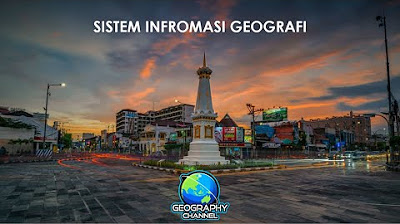Geo X. 52. Teknik Pengumpulan & Pengolahan Data
Summary
TLDRThis video tutorial explores various data collection and processing techniques in geographic research. Key methods discussed include direct and indirect observation, interviews (personal, structured, unstructured, and in-depth), questionnaires, and documentary evidence. The video also covers secondary data collection, the use of geospatial tools like maps and remote sensing, and the processing of quantitative data through coding, reduction, presentation, and conclusion verification. These methods are essential for gathering, analyzing, and interpreting geographical data effectively, providing valuable insights for research.
Takeaways
- 😀 Observation is a data collection method involving direct or indirect observation of phenomena, where direct observation involves the researcher being present during the event, and indirect observation is done after the event has occurred.
- 😀 Interviews are a crucial data collection technique, with different types: personal interviews (one-on-one), structured interviews (using predetermined questions), unstructured interviews (spontaneous questioning), and in-depth interviews (detailed exploration of topics).
- 😀 Questionnaires are another effective data collection method, offering open-ended (long answers) or closed-ended (short, specific answers) questions. They can be distributed face-to-face, by mail, or online.
- 😀 Documentary evidence or literature review gathers data from books, research papers, encyclopedias, and online sources, offering a broader scope than a typical documentary study by diving into historical data from previous research.
- 😀 Secondary data collection involves using pre-existing data from external sources like government agencies, institutions, or past research. It often includes statistical charts, graphs, and tables.
- 😀 Map and remote sensing data collection is used when studying spatial characteristics, such as population distribution, urban development, or environmental changes, typically involving geographical maps and remote sensing technologies.
- 😀 Quantitative data processing involves several stages: sorting, coding, presenting data visually through graphs or tables, and drawing conclusions from the analysis.
- 😀 Coding data is an essential part of quantitative analysis, where data is grouped and categorized for easier analysis and interpretation.
- 😀 Data presentation involves creating visual representations such as diagrams, tables, or graphs to make information more digestible and to facilitate drawing conclusions.
- 😀 The final step in quantitative data processing is conclusion drawing and verification, where patterns are identified, themes are organized, and research findings are finalized and presented.
- 😀 The overall process of data collection and processing in geographical research is methodical, requiring careful planning, attention to detail, and systematic analysis to ensure accuracy and reliability.
Q & A
What is the primary focus of the video script?
-The primary focus of the video script is on various methods of data collection and processing in geographical research.
What are the two types of observation methods mentioned in the script?
-The two types of observation methods are direct observation (where the researcher observes events firsthand) and indirect observation (where tools are used to observe after events have occurred).
How is direct observation different from indirect observation?
-Direct observation involves the researcher being physically present to observe an event as it happens (e.g., floods or eruptions), while indirect observation uses tools to observe and gather data after the event has concluded.
What role does neutrality play in interviews according to the script?
-Neutrality is essential in interviews as the researcher should not influence or lead the respondent's answers. The researcher must depend solely on the responses given by the respondent.
What are the different types of interviews mentioned, and how do they differ?
-The four types of interviews mentioned are: 1) Personal interviews (one-on-one), 2) Structured interviews (based on 5W1H questions), 3) Unstructured interviews (spontaneous and free-flowing), and 4) In-depth interviews (focused on detailed, personal insights).
What is the difference between open-ended and closed-ended questionnaires?
-Open-ended questionnaires allow respondents to provide detailed answers, while closed-ended questionnaires require brief and specific answers, usually in the form of yes/no or multiple choice responses.
How is documentary research different from other data collection methods?
-Documentary research involves gathering data from existing written sources, such as books, scientific articles, or online resources. This method does not involve direct interaction with the research subjects like interviews or observations.
What is secondary data collection, and when is it useful?
-Secondary data collection involves using existing data or documents produced by other organizations or research bodies. It is useful when primary data is not available or when the researcher wants to complement existing research.
How are financial data and geographic data collected in geographical research?
-Financial and geographic data can be collected using maps, remote sensing technology, and geographic information systems (GIS) to analyze economic and geographical features.
What are the key steps in processing quantitative data, as outlined in the script?
-The key steps in processing quantitative data include organizing the data, coding it, grouping the data according to research needs, and then presenting it through diagrams or tables for analysis and conclusion drawing.
Outlines

Esta sección está disponible solo para usuarios con suscripción. Por favor, mejora tu plan para acceder a esta parte.
Mejorar ahoraMindmap

Esta sección está disponible solo para usuarios con suscripción. Por favor, mejora tu plan para acceder a esta parte.
Mejorar ahoraKeywords

Esta sección está disponible solo para usuarios con suscripción. Por favor, mejora tu plan para acceder a esta parte.
Mejorar ahoraHighlights

Esta sección está disponible solo para usuarios con suscripción. Por favor, mejora tu plan para acceder a esta parte.
Mejorar ahoraTranscripts

Esta sección está disponible solo para usuarios con suscripción. Por favor, mejora tu plan para acceder a esta parte.
Mejorar ahoraVer Más Videos Relacionados

Sistem Informasi Geografi (Pengertian, Komponen, Data, Tahapan, Manfaat)

BAB 3 PENELITIAN GEOGRAFI | X SMA / MA | KURIKULUM MERDEKA

PENELITIAN GEOGRAFI KELAS 10

Tutorial-4: Working with Graphs in SystemVue

Praktikum SIG Kehutanan (Geoprocessing Tools) Menggunakan Software QGIS

Analisis Data - Informatika
5.0 / 5 (0 votes)
